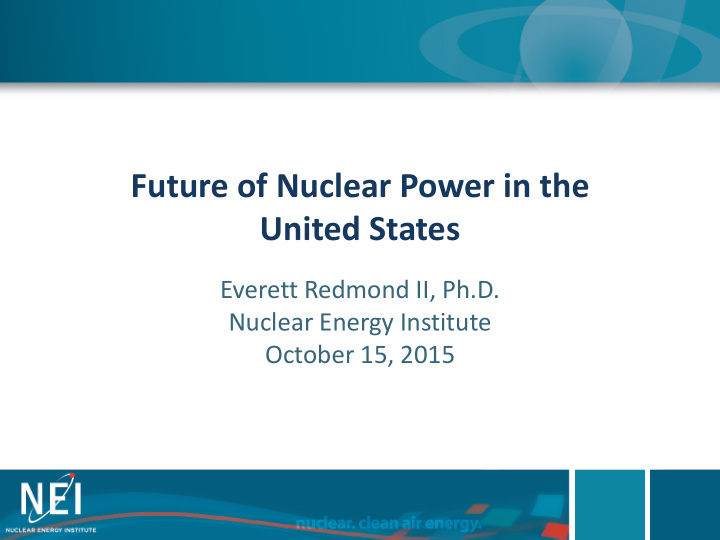



Future of Nuclear Power in the United States Everett Redmond II, Ph.D. Nuclear Energy Institute October 15, 2015
If All U.S. Reactors Retire After 60 Years of Operation Year Total U.S. Nuclear Nuclear Nuclear Fuel New Generation Electric Demand Capacity Generation Share Needed to Meet Fuel (bkWh) (GW) (bkWh) Share (GW) 20% 25% 2015 4,134.3 100.2 790.2 19.1% 2020 4,351,3 104.0 820.0 18.8% 6.4 34.0 2025 4,513.2 104.0 820.0 18.2% 10.5 39.1 2030 4,691.2 100.0 788.0 16.8% 19.1 48.8 2035 4,860.4 72.4 570.4 11.7% 50.9 81.8 2040 5,055.5 57.5 453.2 9.0% 70.8 102.8 2
If All U.S. Reactors Retire After 80 Years of Operation Year Total U.S. Nuclear Nuclear Nuclear Fuel New Generation Electric Demand Capacity Generation Share Needed to Meet Fuel (bkWh) GW (bkWh) Share (GW) 20% 25% 2015 4,134.3 100.2 790.2 19.1% 2020 4,351,3 104.0 820.0 18.8% 6.4 34.0 2025 4,513.2 104.0 820.0 18.2% 10.5 39.1 2030 4,691.2 104.0 820.0 17.5% 15.0 44.7 2035 4,860.4 104.0 820.0 16.9% 19.3 50.1 2040 5,055.5 104.0 820.0 16.2% 24.2 56.3 3
The Long-Term Vision NEI Annual Plan: Supported by political and public acceptance of nuclear power, policies are in place to ensure nuclear energy expands as the leading provider of carbon-free energy into the 2030s. Large light water, small modular light water, and advanced reactor technologies should be pursued. All have a role in the future of nuclear power.
2025 2030 2015 2020 By 2020 Vogtle 3 and 4, Summer 2 and 3, Watts Bar 2 in service successfully Certainty on small modular reactor commercial availability Design certifications for NuScale SMR Demonstrated regulatory framework for second license renewal
2025 2030 2015 2020 Early 2020s Decisions on whether or not to pursue license renewal for oldest plants (minimum 5 years out to qualify for timely license renewal) Begin construction of new nuclear generating capacity to (1) hold nuclear at 20%, or (2) replace nuclear capacity retiring at 60 years Complete FOAK engineering on SMRs; ready for deployment
2025 2030 2015 2020 In 2025 10.5 GW of new nuclear capacity on line to stay at 20% (very unlikely) Beginning of capex cycle necessary for plants going past 60 years
2025 2030 2015 2020 In 2030 First reactors reach 60 years Approx. 31,000 MW of nuclear capacity reaches 60 years by 2035 (replacement cost ~$250 billion) EPA’s 111(d) target: 32% reduction in carbon emissions Need 15-19 GW of new nuclear capacity on line to stay at 20% (12,500 MW now in active licensing) Only 23.5 GW (about 8%) of today’s coal-fired capacity <25 years old Only 122 GW (about 28%) of today’s gas-fired capacity <25 years old
Challenges/Opportunities • Growth in electricity demand coupled with aging generation infrastructure • Electricity markets • Clean Power Plan • Worldwide expansion of nuclear power • New energy markets
Priorities • Existing fleet - Market conditions - attributes of nuclear appropriately valued - Second license renewals • SMRs – operational in the 2020s - NEI SMR Working Group • Advanced reactors - NEI Advanced Reactor Working Group – utility interest
Advanced Reactor Designs • Will they be able to operate for 40, 60, 80 years? • Will they have a capacity factor comparable to existing LWRs? • Can the construction be simplified and the cost reduced? • Can the licensing process be simplified?
Advanced Reactor Development • Significant private investment • Environmental community interest – Clean Air Task Force • Congressional interest • DOE study on the need for a material test reactor and/or demonstration reactor • Industry interest
Questions? Everett Redmond Nuclear Energy Institute elr@nei.org 202-739-8122
Recommend
More recommend